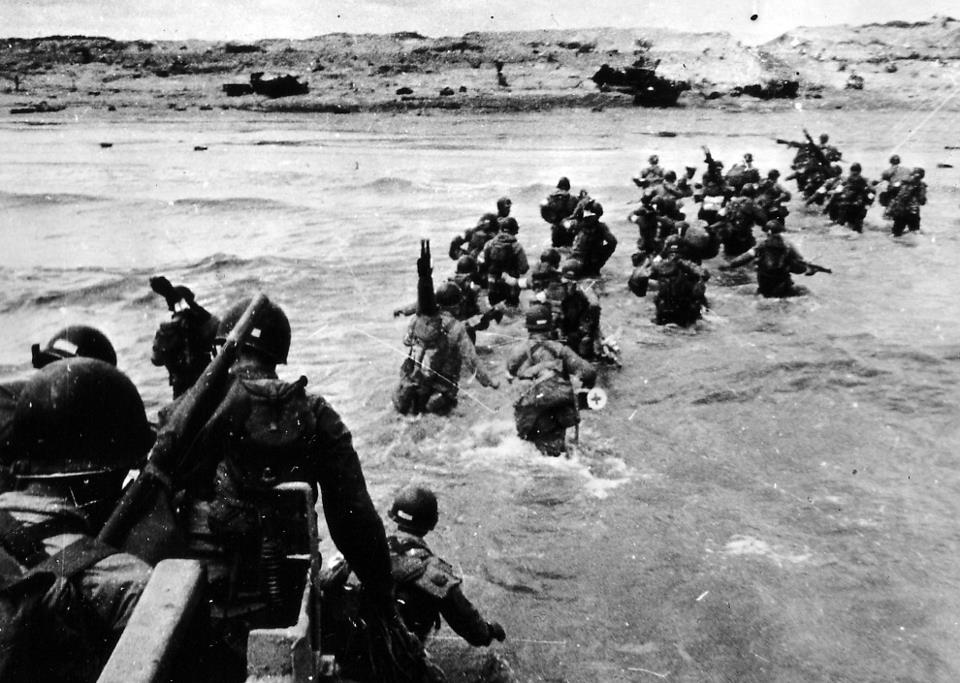Written by Vivian Martin, Project Director
Hundreds of books and articles have been written about D-day from many different angles. The day is also the subject of numerous famous movies, most notably The Longest Day (1962) and Saving Private Ryan (1998). But the web offers quick access to the articles and digital materials being offered as the 70th anniversary approaches. We’ll be updating information on ongoing media coverage, and doing some of that ourselves, but here are some articles, websites and blogs that offer different dimensions to the story.
- Here’s a way to see D-day as it happened. The National World War II Museum drew on its collection of maps, photos and videos with eyewitness interviews to allow visitors to its website to move through a timeline looking at events in the hours of strategizing before H-hour and beyond.
- Historian Douglas Brinkley reflects on the importance of June 6, 1944 to the 20th century in this Time essay. Some interesting thoughts about what failure would have meant.
- Photojournalist Robert Capa is responsible for the iconic D-day images that appeared in Life magazine. The Hungarian-born photojournalist covered several wars and landed with troops on Omaha, which is where he shot the images we now associate with D-Day.Vanity Fairexplores the photos he shot and many more he lost.
- Annie Darling is a journalism student from London who kept a lively and informative blog on the 69th D-Day commemorations for Normandy Tourist Board and is back blogging again this year.
- Over at the New York Times Upshot blog, Michael Beschloss, a presidential historian, shares a rare color photo of American Rangers from E Company headed into battle.
- Operation Overlord was top secret, so imagine the alarms that went off when certain D-Day codewords showed up as answers in crossword puzzles for The Telegraph in London. This author wonders whether many people would have the general knowledge and literary sensibility to solve the puzzles today. Try it.
- “The ruins left behind after warfare speak a language of their own,” so begins the essay that accompanies Life’s gallery of Normandy after D-Day. Destruction came with liberation, and the color photos capture that painful paradox.
- Historian Mary Louise Roberts’ “What Soldiers Do” confronts an issue not given much attention in media coverage and other discussions of D-Day and the liberation of Paris: sexual assaults on the women of France, as well as the ways the U.S. military sometimes wrongly accused attacks and sexually transmitted diseases on African American soldiers as scapegoats when prosecuting cases. Roberts examined archival records to piece together the dark side of victory.
- As World War II veterans age, more are talking about their experiences after decades of silence. Jesse Leavenworth and David Owens of the Hartford Courant talks with some who found benefit in breaking the silence both for themselves and future generations.
- Family members who might not have listened much when veterans told their stories are also finding they were missing out. Associated Press writer Beth J. Harpaz writes of how listening to old radio interviews of her father talk about D-Day gave her a second chance to hear stories she’d previously ignored.
- This obit of Helen Denton, a clerk who typed top secret invasion plans for D-Day, shows how such a major operation required the work and trust of people in many different jobs.
- The Whiskey 7, a restored plane that saw combat in Normandy, is crossing the Atlantic to fly over Omaha in June.
- Prior to D-Day, there was a rehearsal drill that went bad, killing 700 people. The accident was kept quiet for years. This Milwaukee Journal Sentinel article tells the story of one man who died.
- Some of us are suckers for anything written about writer Ernest Hemingway in Paris. There are many stories, some probably apocryphal, of the writer’s, World War II adventures, but San Francisco Chronicle writer Michael Taylor traced Hemingway’s steps to show how the famous author liberated the Ritz Hotel in Paris in those tumultuous days of August 1944.
- Photojournalist Margaret Bourke-White was there for the liberation of Buchenwald and captured haunting images of the human devastation, the living and the dead. This Life gallery shows the original May 7, 1945 magazine spread as well as some unpublished work. As an accompanying essay notes, Life’s Buchenwald photos “were among the very first to document for a largely disbelieving public, in America and around the world, the wholly murderous nature of the camps.”

